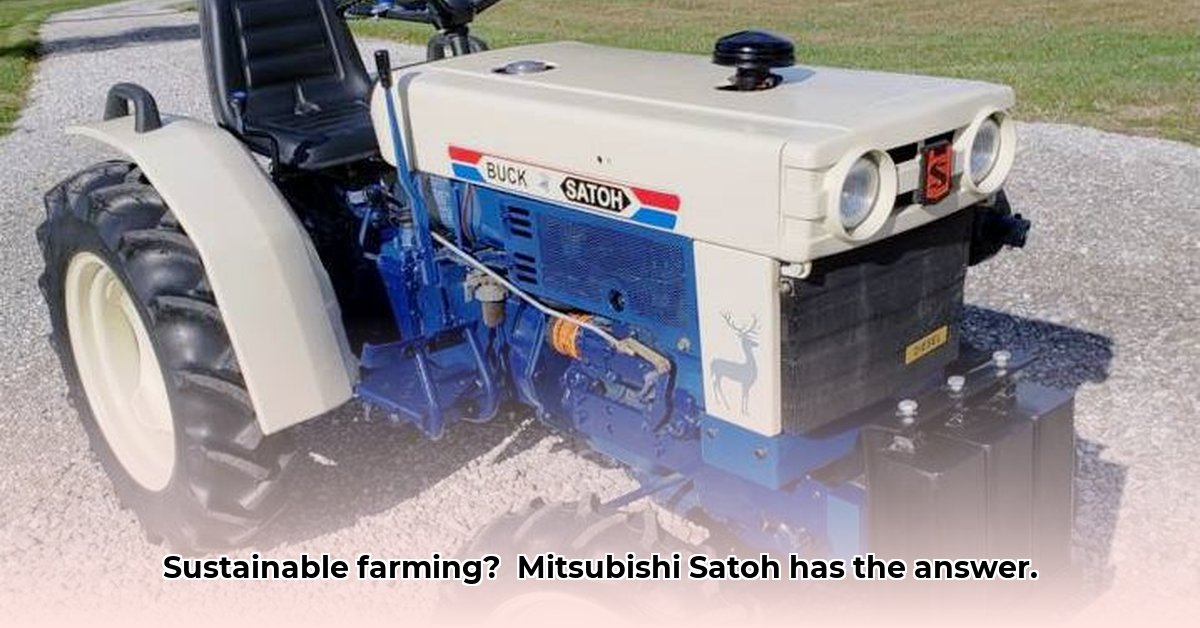
A Legacy of Compact Power
The Mitsubishi Satoh S470 tractor, a product of the now-integrated Satoh brand, represents a significant chapter in sustainable agriculture. This article explores its historical context, design features, and relevance to modern sustainable farming practices. We'll compare it to contemporary compact tractors and discuss its implications for various stakeholders, including small-scale farmers, manufacturers, researchers, and policymakers. The S470's story offers valuable insights into the evolution of sustainable agricultural technology and the ongoing quest for efficient and environmentally responsible farming. For more on compact tractors, see this helpful resource: Massey Ferguson models.
The Satoh Legacy: Efficiency for Smaller Farms
Before its integration into Mitsubishi, Satoh distinguished itself by focusing on smaller, more efficient tractors designed for smaller farms and plots of land. This focus on efficiency anticipated many of the key principles emphasized in modern sustainable agriculture. The S470, a prime example of this philosophy, prioritized fuel efficiency and maneuverability over sheer power, making it a suitable choice for environmentally conscious farmers. Did this focus pay off? Let's examine its specifications.
The S470: Design for Sustainability
The S470's compact design minimized soil compaction, a crucial element in maintaining soil health and long-term productivity. Its relatively small 18.5 horsepower engine and 4-gallon fuel tank were engineered for optimal fuel efficiency. This translated to lower fuel costs and reduced environmental impact. However, its limitations also highlight the evolving nature of "sustainability."
Sustainable Farming: A Balancing Act of Efficiency and Modernization
While the S470's compact size and fuel efficiency are commendable, it's essential to acknowledge its limitations. Its hydraulic system, featuring a modest 3.5 gallons per minute (gpm) pump and 1100 lb lift capacity, was significantly less powerful than its modern counterparts. This restricted its versatility, limiting its compatibility with advanced farming implements. Furthermore, its mechanical steering and drum brakes, while reliable, lack the precision and automation of today's technologically advanced tractors. Therefore, we must analyze the S470's impact within the context of evolving sustainability standards.
The S470 vs. Modern Compact Tractors: A Comparative Analysis
To fully assess the S470’s relevance, a comparison to modern compact tractors is necessary. Contemporary models boast substantially larger hydraulic capacities, integrated GPS guidance systems, and advanced electronic controls. These features enhance precision, reducing fuel wastage and maximizing yields—achievements far exceeding the S470’s capabilities. While the S470's fuel efficiency and compact size were groundbreaking for its time, current technology significantly elevates the standards of sustainable agriculture. How can we reconcile these differences?
Stakeholder Perspectives and Future Implications
The S470's legacy holds diverse implications for various stakeholders:
Small-scale farmers: The S470 might still be suitable for certain tasks, pending a careful cost-benefit analysis of repair costs versus the acquisition of newer models offering improved capabilities.
Manufacturers: The S470's design provides valuable insights into the principles of compactness and fuel efficiency. Modern manufacturers can leverage these principles to develop even more efficient and sustainable tractors.
Researchers: Studying the S470’s fuel consumption and environmental impact can inform future tractor designs. This data can optimize sustainable agricultural practices.
Policymakers: Implementing incentives for fuel-efficient and technologically advanced tractors could accelerate the transition to more environmentally responsible agriculture.
Risk Assessment and Mitigation Strategies
Using older equipment like the S470 involves inherent risks:
| Factor | Risk Level | Mitigation Strategy |
|---|---|---|
| Limited Hydraulic Capacity | Medium | Consider lighter implements; supplement with other equipment; consider newer models. |
| Technological Limitations | High | Modern tractors offer greater precision, often offsetting higher initial investment. |
| Parts Availability | Medium | Utilize specialized dealers; expect longer lead times and potentially higher costs. |
| Relative Fuel Efficiency | Low | Ensure appropriate maintenance for optimal fuel economy; optimize farming procedures. |
Regulatory Considerations and Future Outlook
Stringent environmental regulations present uncertainties. While the S470 might remain operational for some time, stricter future regulations may render it obsolete. Sustainable agriculture necessitates continuous technological advancement, and the S470 serves as a reminder of this ongoing process.
Conclusion: A Legacy of Innovation and the Path Forward
The Mitsubishi Satoh S470, while limited by its age, represents a pivotal point in the journey towards sustainable agriculture. Its compact design and relative fuel efficiency foreshadowed many of the principles embraced in modern sustainable farming. However, its limitations underscore the need for ongoing innovation and the adoption of advanced technologies to optimize efficiency and minimize environmental impact. The S470’s legacy is one of innovation, but the future of sustainable farming lies in embracing modern advancements.